SVETLANA PANASYUK
 Home Home
 Resume Resume
 Publications Publications
Medical Hyperspectral Imaging
 Basics Basics
 Device Device
 Diabetes Diabetes
 Wounds Wounds
 Cancer Cancer
 Shock Shock
Optical Metrology
 Defects Defects
 Medical Medical
 Automotive Automotive
Tissue Spectroscopy
 Fluorescence Fluorescence
 D-Reflectance D-Reflectance
 Device Device
Mantle Flow
 Convection Convection
 Drift Drift
 Geoid Geoid
 Compressibility Compressibility
 Inversion Inversion
 Topography Topography
 Phases Phases
 Superplasticity Superplasticity
 Hemisphere Hemisphere
GPS
 Tien Shan Tien Shan
 GPS GPS
 Sky Map Sky Map
 Errors Errors
Remote Sensing
 Vectors Vectors
 Satellites Satellites
Image Processing
 Deblurring Deblurring
 Registration Registration
 Recognition Recognition
Fun
 Geosystems Geosystems
 Colormap Colormap
 Chaos Chaos
 Bubbles Bubbles
 Harmonics Harmonics
Reference Earth Model
 about about
 data data
 map_view map_view
 slice slice
 isosurface isosurface
 rms rms
 correlation correlation
 vis5D vis5D
|
 |
 |
 |
|
 Counting the Red Blood Cells or
finding their concentration in the solution appeared to be an important problem (as I recently found out).
Many people spend their valuable time and priceless eye sight counting similar features (e.g., Red Blood Cells)
looking through the microscope lenses and clicking the counter everytime they identify a cell. Counting the Red Blood Cells or
finding their concentration in the solution appeared to be an important problem (as I recently found out).
Many people spend their valuable time and priceless eye sight counting similar features (e.g., Red Blood Cells)
looking through the microscope lenses and clicking the counter everytime they identify a cell.
I have done some work automating the counting process and came up
with a self-learning, iterative algorithm in Matlab.
Below is an example of
a typical microscope-acquired image of a red blood cell solution (top left panel).
The grid lines facilitate manual counting,
but complicate the automated count, because they reduce contrast of the cells
overlaping the grid lines. A magnified portion of the image (bottom left panel)
reveals the donut-like looking red blood cells, and the complexity of the task
identifying a cell. Usually, a human counts the cells with ~ 4-5% error.
A computer, on the other hand, gives a pretty robust answer :)
My Matlab code gives a total Red Blood Cell count in the top right panel as 2644.
To verify the algorithm quality, you could compare the two lower panels.
Do you agree with the algorithm on identified cells?
full original image
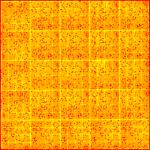
| same image as to the left, but processed.
Consists of 2644 cells
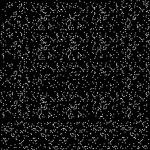
| top left corner of the image above,
magnified
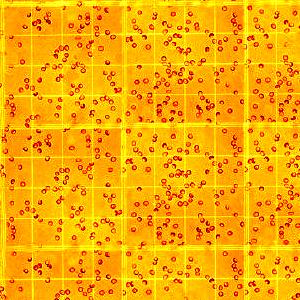
| same location as to the left, but processed.
Consists of 631 cells
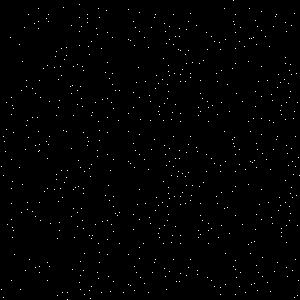
|
Some of the cells are easy to identify, some cross through the microscope's grid and
appear disturbed. Sometimes it's even hard for a person to tell if this is a cell
or something else (dirt). Especially, if there are thousands of cells to count.
That is why a human error is so big.
Try it yourself, come on, just for fun of it! Count cells in the
lower left image a few times and compare the results.
My older son & me counted 5 times and got 610, 657, 657, 583, 650 cells.
The estimated error (standard deviation) came as 5% with an average of 630 cells,
which makes cell count in a range between 598 and 662.
The algorithm gives 631 cells - inside the human estimated range.
It usually takes ~ 8-10 iterations for the algorithm
to reach the final answer.
The progress of the iterations, convergence, is shown below:
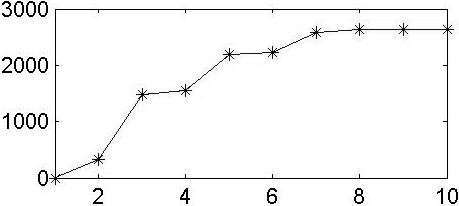
Since you have to provide the algorithm with a notion what do you call a Red Blood Cell,
it will successfully work on other "features" that need to be counted
in an image. As long as you know what you're looking for :)
Many thanks to Northland Community Colledge for making the data public available.
Since so many people have contacted me asking for the code, I put it here. This image is used in example provided in the help (Download both files & type >> help countCells in the matlab window.) You could use the code as is, but please honour the authorship. If you need additional help on your particular application, I'd be happy to consult.
Work was done while at Argose Inc.
|
|

 Counting the Red Blood Cells
Counting the Red Blood Cells


